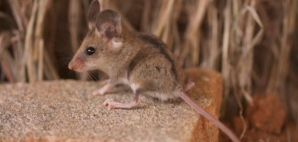Large Animals Help Prevent Disease in Humans
« Back to This Page Has Moved...
 Changes in abundance, rather than diversity, of rodents such as this Gray climbing mouse drove increases in disease risk during a field study
Changes in abundance, rather than diversity, of rodents such as this Gray climbing mouse drove increases in disease risk during a field study Photo credit: Lauren Helgen
Large Animals Help Prevent Disease in Humans
By temporarily removing large mammals from an ecosystem, Stanford scientists discovered that populations of disease-carrying rodents grew unchecked, increasing the risk of transmitting deadly pathogens to humans.
Don't let their cute names fool you: the Mearns' pouch mouse and the delicate mouse can be dangerous.
These and other rodents commonly harbor pathogens that can be deadly to humans. According to new research by Stanford scientists, populations of pathogen-carrying rodents can explode when larger animals die off in an ecosystem, leading to a doubling in the risk of potentially fatal diseases spreading to humans.
"It has tremendous consequences for us," said co-author Rodolfo Dirzo, a Stanford professor of environmental science and senior fellow at the Stanford Woods Institute. "Our data suggest that maintaining healthy populations of mega fauna helps us stay in good shape in terms of avoiding nasty bacteria."
The study is published in the journal Proceedings of the National Academy of Sciences.
Around the world, large animal species are dying off rapidly in the face of hunting or poaching, or indirectly via deforestation and other human impacts. More than half of all mammal species, for example, are declining. Such human impact on fauna, however, is differential: As the numbers of large mammals are declining, the numbers of small mammals, such as rodents, are increasing.
To study the potential health impacts of these large animal population declines, the researchers fenced off multiple 2.5-acre (4-hectare) plots of savanna land in Kenya, preventing access by elephants, giraffes, zebras and other large animals. Over the course of two years, the number of rodents in the study areas doubled, most likely because of increased availability of food and cover, among other reasons.
With more rodents came more of the pathogen-infected fleas they carry and increased disease risk for people. The study specifically examined the prevalence of Bartonella, a group of bacteria found throughout the world that can cause long-term damage to the human heart, brain, lungs and spleen.
"This is an underappreciated and insidiously simple route by which human change can drive disease risk," said study lead author, Hillary Young, who conducted the research as a biology graduate student at Stanford and is currently an assistant professor at the University of California, Santa Barbara.
More than 60 percent of all human disease originates with pathogens carried by animals. Flea-transmitted pathogens are found everywhere from suburban enclaves to tropical forests. In East Africa, where rodent-borne disease is common, typhus and even the plague can spread via human contact with infected rodents. Most health clinics in the region are unprepared to detect, let along treat, some of these diseases.
Dirzo, Young and their colleagues, including Stanford Woods Institute research associate Dan Salkeld and former Stanford biology graduate student Douglas McCauley, plan to expand the research to look more closely at the cascade effect of large animal decline on human health. Among other analyses, they intend to study how different types of land use affect the prevalence of a wide variety of rodent-borne pathogens and how the risk of disease from these pathogens matches up with actual disease prevalence in people.
The Stanford Woods Institute has supported Rodolfo Dirzo's study of the effects of the loss of wildlife on disease risk through its Environmental Venture Projects seed grant program. Read more about Dirzo's research.
